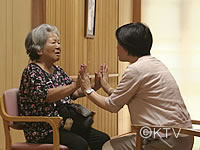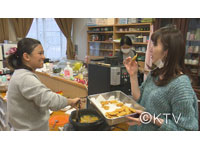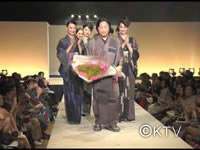TV Station KTV
Empathy as Therapy: Bringing New Hope to Dementia Caregiving
DC291635![]()
生きること 認知症の心に寄り添う「バリデーション」 [KTV]
![]()
![]()

|Length : 47min |Year : 2016 |
It is predicted that by 2025, one in every five Japanese people over the age of 65 will be afflicted with dementia. Care for increasing dementia patients is urgent, but conditions for caregivers are harsh, and shortage of personnel is a serious problem. How can we give our loved ones the care they deserve?Naoko Tsumura, professor at Kansai University of Welfare Sciences, embraces “Validation”, a method to empathize and foster better communication with dementia patients. In nursing homes that have introduced Validation, the relationships between caregivers and families, and the patients, have slowly improved, providing new hope for all.
The Struggles and the Dreams of Foreign Care Workers in Japan
DC281868![]()
さくらの国に来て、、、 [KTV]
![]()
![]()

|Length : 55 |Year : 2018 |
It is said that in Japan, with an aging society, there will be a shortage of 340,000 care workers by 2025. For care centers, it is essential to welcome help from abroad.
In our program we follow two Indonesians who have come to Japan under an EPA program signed between Japan and Indonesia. They have been working at a welfare center, Hachikikai, since December 2017, at the same time studying to become certified care workers.
Under the EPA program, if they pass the certification exam within four years, they can stay and work in Japan. At Hachikikai, the staff fully supports them and helps them study even during work hours. The reason is that they want the two to continue working at their center. The staff at Hachikikai are kind and treat them as family, however they still have their own difficulties and worries.
Our program shows a very real picture of the struggles, hopes and dreams of these and other Indonesian people working hard in a land far from home.
KANSAI WORKER ~The Contemporary Kimono Designer~
DC241756![]()
よ~いドン!発見!関西ワーカー 和を楽しむスタイルを提案する着物デザイン・プロデューサー [KTV]
![]()
![]()

|Length : 21 |Year : 2017 |
The kimono is a traditional garment of Japan, and its culture is one Japan boasts to the world.
There is a man who unceasingly challenges himself to arrange the kimono in a variety of ways to make it blend into contemporary lifestyles. That man is kimono designer Jotaro Saito, who is the third generation owner of Sansai, an established kimono textile dyeing company in Kyoto.
Saito’s designs are not confined to the realm of kimono fashion, as they are even used on furniture and lamps that adorn interiors of prestigious hotels. With his works, he continues to open up new possibilities for the kimono.
Although Saito’s works are based on the traditional beauty kimono offer, Saito incorporates casual patterns to make the kimono fun for the wearer.
In addition to the use of such patterns, he has created stretchy kimono made of polyester and others that even feature metal studs by Swarovski.
In this program, comedic duo Rozan step inside the studio to take a look at the dyeing process. The two learn about the techniques involved, and marvel at the delicacy of the work involved. And then, they finally try out the dyeing process themselves.














